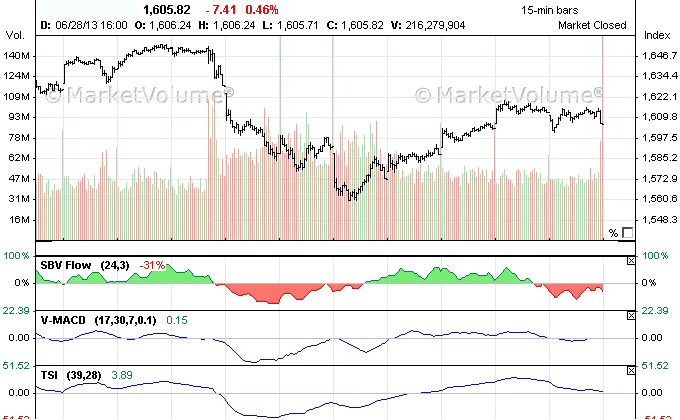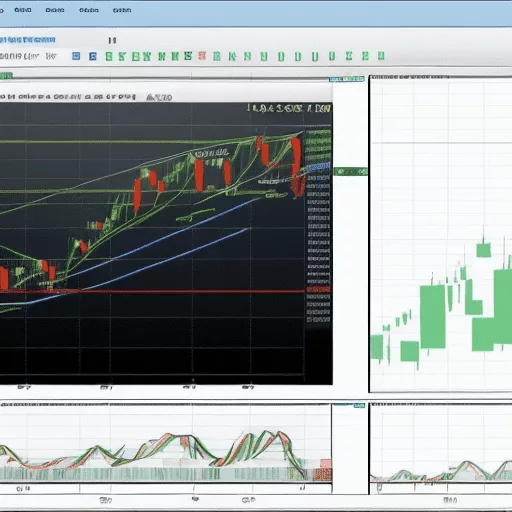Do you have a desire to know if a stock will undergo a gap up? Being a devoted observer of the stock market, I have dedicated infinite hours understanding the nuances of trading. I have always been intrigued by the occurrence of ‘gaps’. These are moments when a notable increase or decrease in a stock’s price occurs from the conclusion of one day to the beginning of the next, creating an evident gap in the chart.
These gaps can offer valuable insights and potentially profitable opportunities for traders who know how to spot them and act accordingly. But the million-dollar question remains: how can we predict when a stock will gap up and use that knowledge to our advantage?
Well, my fellow aspiring stock market masters, the key lies in understanding the context and causes behind gaps, as well as developing a well-rounded strategy that incorporates both fundamental and technical analysis.
In this article, we’ll delve into the world of gaps, exploring how to identify potential gap candidates and interpret pre-market indicators, as well as how to integrate technical indicators for a more comprehensive and effective gap trading approach.
So, buckle up and get ready to transform those gap insights into profitable day trading strategies!
Decoding Gaps and Their Context in Stock Market Trading

As a stock market enthusiast, I’m always looking for ways to improve my trading strategies. Recently, I’ve been interested in understanding the difference between common breakaway, runaway, and exhaustion gaps. I want to learn how to identify them based on technical chart patterns and market conditions.
I’m eager to delve deeper into the relationship between gap types and predicting gaps. I believe this knowledge could significantly enhance my trading success.
Difference Between Common, Breakaway, Runaway, and Exhaustion Gaps
It is fascinating to explore the difference between common breakaway, runaway, and exhaustion gaps in the stock market! These gaps can provide valuable insight into potential market moves and offer a chance to capitalize on opportunities.
Here’s a quick rundown of the difference between gaps:
- Common Gap: These are small price gaps that occur frequently and aren’t typically significant for trading. Minor news or events might cause them, but don’t show a strong trend or major market move.
- Breakaway Gap: This type of gap signals the start of a new trend and is usually accompanied by high trading volume. A breakaway gap might occur after a period of consolidation, with the stock breaking out of a trading range, or following a significant news event that impacts the stock’s value.
- Runaway Gap: When a stock is during a strong trend, a runaway gap can occur. This gap is a sign of continued momentum in the stock’s direction, either up or down, and often attracts more traders to join the trend, further fueling its movement.
- Exhaustion Gap: An exhaustion gap signals the end of a trend as it occurs when the stock has reached an extreme level and is about to reverse its direction. It’s often seen after a prolonged move in one direction, and traders might use this as an opportunity to take profits or start a counter-trend trade.
Understanding these differences will aid in identifying gaps based on technical chart patterns and market conditions, helping you make more informed trading decisions.
Identifying Gaps Based on Technical Chart Patterns and Market Conditions
Imagine being able to spot potential trading opportunities just by recognizing gaps in technical chart patterns and market conditions–that’s the power of understanding the distinct gaps in the stock market. To identify a potential gap up opening, you’ll need to study price patterns, stock price movements, and overall market conditions to increase the likelihood of making profitable trades. Let’s examine some key factors in a simple table:
| Factor | Description | Example |
|---|---|---|
| Technical Chart Patterns | Look for bullish chart patterns such as double bottoms | ascending triangles, and cup and handle formations. These patterns often signal a potential gap up. |
| Double bottom, Ascending triangle, Cup and handle | Stock Price | Observe the stock’s price action and look for strong upward momentum, increased volume, and positive news catalysts. These factors can contribute to a gap up opening. |
| Strong upward momentum, Increased volume, Positive news catalyst | Market Conditions | Analyze the overall market conditions. A bullish market environment or positive sector news can lead to gap ups in individual stocks |
By mastering the art of identifying gaps based on technical chart patterns and market conditions, you’ll be better equipped to predict potential gap up openings and seize lucrative trading opportunities. Now, let’s dive deeper into exploring the relationship between gap types and predicting gaps.
Exploring the Relationship Between Gap Types and Predicting Gaps
Did you realize that about 70% of stocks move in the same direction as the overall market? Understanding the relationship between gap types and predicting gaps can significantly improve your chances of making profitable trades.
Familiarizing yourself with different gap types, such as breakaway, runaway, exhaustion, and common gaps, can help you better expect a stock gap up, allowing you to capitalize on these opportunities. Mastering gap analysis and incorporating it into your trading strategies not only gives you a competitive edge but also enhances your ability to make informed decisions in a constantly changing market.
So, are you ready to take your trading game to the next level? Let’s dive deeper and uncover potential price gaps through extensive stock research!
Uncover Potential Price Gaps Through Extensive Stock Research

As an avid stock trader, I’ve learned the importance of uncovering potential price gaps through extensive research.
By tracking historical gap patterns, I can identify trends and recurrences. Assessing a stock’s volatility, liquidity, and Relative Strength Index (RSI) also helps me make informed decisions on potential gap opportunities.
Investigating news events impacting stock sentiments and prices is also crucial in my research.
These strategies combined allow me to capitalize on potential gap opportunities and enhance my trading game. I’m excited to share these insights with fellow traders.
Track Historical Gap Patterns to Identify Trends and Recurrences
By tracking historical gap patterns, you’ll uncover trends and recurrences that can offer valuable insights into a stock’s potential to gap up in the future. Here are some key aspects to consider when analyzing historical gap patterns:
- Look for previous instances of a stock gap up and note the factors that contributed to those events.
- Observe the stock’s overall trend and determine if it’s in a bullish or bearish phase.
- Examine the stock’s reaction to market news, earnings announcements, and other significant events that could impact its price.
- Study the stock’s price action around support and resistance levels to understand how it behaves in various scenarios.
- Identify recurring patterns, such as specific days of the week or times of the year, when the stock tends to gap up.
Gaining a deeper understanding of a stock’s historical gap patterns and trends will help you better expect potential price gaps. With this knowledge in hand, you’re now ready to assess the stock’s volatility, liquidity, and relative strength index (RSI) for even more insight into its potential to gap up.
Assess Stock’s Volatility, Liquidity, and Relative Strength Index (RSI)
To truly tap into a stock’s potential for future growth, turn your attention to assessing its volatility, liquidity, and relative strength index (RSI)–vital variables when vetting viable investments.
First, determine how much the stock will gap up by examining its volatility, which can show the potential for large price swings.
Then, explore the liquidity of the stock by evaluating its trading volume; higher liquidity often translates to a smoother ride in the market, with less risk of sudden price drops.
Finally, consider the stock’s RSI, a momentum indicator that measures the speed and change of price movements. RSI values range from 0 to 100, where values above 70 typically suggest overbought conditions, while values below 30 hint at oversold and potentially undervalued stocks.
By carefully analyzing these factors, you’ll be better equipped to spot opportunities for significant growth in the stock market.
Now, to further refine your investment choices, dive into investigating news events that impact stock sentiments and prices.
Investigate News Events Impacting Stock Sentiments and Prices
After assessing a stock’s volatility, liquidity, and RSI, it’s crucial to dive deeper and investigate news events that can influence stock sentiments and prices. News events play a significant role in causing a stock to gap up or down, as they can alter investors’ perceptions and create buying or selling pressure.
To stay ahead in the game, consider the following factors when investigating news events:
- Earnings announcements: Companies release their quarterly earnings reports, which can significantly impact stock prices depending on whether they beat, meet, or miss expectations.
- Product launches or updates: New products or updates to existing products can boost a company’s stock prices if the market reacts positively to the news.
- Mergers and acquisitions: These events can create excitement around a stock, leading to increased demand and a potential gap up.
- Macroeconomic data: Pay attention to economic indicators, such as interest rates, inflation, and unemployment rates, as they can influence the overall market sentiment and impact individual stocks.
By keeping a close eye on these news events and understanding how they affect stock sentiments, you’ll be better prepared to spot potential gap ups.
Now that you have a solid foundation, it’s time to delve into the art of deciphering pre-market indicators for gap trading strategies.
The Art of Deciphering Pre-Market Indicators for Gap Trading Strategies

As a savvy investor, I understand the importance of deciphering pre-market indicators for gap trading strategies. This includes analyzing pre-market volume and price changes in stock gap prediction. To gain an edge in the market, I sync my timing with market makers for helpful gap trades.
I also make it a point to study competitor stocks and relevant sector developments pre-market to make well-informed decisions.
Importance of Pre-Market Volume and Price Changes in Stock Gap Prediction
Predicting stock gaps becomes clearer when you’re closely watching pre-market volume and price changes, as they offer valuable insight into potential movements at the opening bell. There are three key reasons this is crucial in stock gap prediction:
- Pre-market volume: can provide a sign of the level of interest in a particular stock. Higher pre-market volume suggests that the stock is being traded actively, which increases the chances of a gap up at the opening price.
- Price changes: during the pre-market session can give you a sneak peek into the market sentiment towards the stock. For instance, if a stock is showing significant positive price changes in the pre-market, it’s likely that the momentum will continue when the market opens, leading to a gap up.
- Opening price: dynamics are crucial in determining the chances of a gap up. A stock with a higher opening price compared to the previous day’s close shows that there is a strong demand for the stock, which can cause a gap up.
By understanding these factors and their interplay, you’ll be better equipped to predict stock gaps and make informed trading decisions.
Now, let’s dive into how to sync your timing with market makers for helpful gap trades and further enhance your mastery of the stock market.
Sync Your Timing with Market Makers for helpful Gap Trades
Imagine being in sync with market makers, effortlessly riding the wave of helpful gap trades and boosting your profits like a seasoned pro.
To achieve this, you’ll need to closely monitor trading volume and the price actions of stocks before the market opens, as market makers influence these figures to create optimal trading opportunities. By monitoring how they manipulate the trading volume, you can identify potential gap ups or downs and make well-informed decisions during the trading session.
The key is to stay proactive and adaptive, following the footsteps of these market movers to capitalize on profitable opportunities as they arise. And as you sharpen your instincts and refine your strategies, don’t forget to observe competitor stocks and relevant sector developments in pre-market—another crucial aspect of mastering the art of gap trading.
Observe Competitor Stocks and Relevant Sector Developments Pre-Market
You’ll significantly boost your trading game by keeping a close eye on competitor stocks and relevant sector developments before the market opens. This is because a gap up often occurs when a stock’s price is significantly influenced by performing its competitors or changes within its sector.
By monitoring pre-market activities and news surrounding competitor stocks and sector developments, you can identify potential gap-up candidates and make more informed decisions when trading. Being in tune with the market and staying updated on the factors that might affect a stock’s performance will give you an edge over other traders who might not be as well-prepared.
Now that you’re aware of the importance of observing competitor stocks and sector developments, it’s time to delve deeper into integrating technical indicators to effectively identify gap candidates.
Integrating Technical Indicators to Effectively Identify Gap Candidates

As a trader, I often integrate key technical indicators like Moving Averages, Bollinger Bands, and MACD to effectively identify potential gap candidates in the stock market.
Combining multiple indicators allows me to achieve greater accuracy in predicting gaps. Evaluating support and resistance levels helps in confirming those potential gaps.
This holistic approach to analyzing market data enables me to make more informed decisions and develop profitable gap trading strategies.
Adopt Key Indicators like Moving Averages, Bollinger Bands, and MACD
By adopting key indicators such as Moving Averages, Bollinger Bands, and MACD, it becomes possible to predict if a stock might gap up–but just wait till you see how these indicators work together to give you a clearer picture.
Moving averages helps you identify trends and reversals, while Bollinger Bands measure volatility and provide insights into potential price movements. Meanwhile, the MACD indicator highlights momentum shifts, confirming the likelihood of a stock gap.
When you combine these powerful key indicators, you’re unlocking the secrets of the stock market, giving you a significant edge in predicting gaps with greater accuracy. As you continue to refine your market analysis skills, you’ll soon master the art of anticipating stock gaps and making well-informed decisions that propel you towards financial success.
Now, let’s dive into how you can combine multiple indicators for even greater accuracy in gap prediction.
Combine Multiple Indicators for Greater Accuracy in Gap Prediction
It’s in the fusion of multiple indicators that you’ll truly unlock the potential for accurately predicting gaps and making savvy investment choices.
Combining multiple indicators like moving averages, Bollinger Bands, and MACD can provide a more comprehensive view of the market and increase the chances of identifying when a stock will gap up.
By using these tools with each other, you can paint a clearer picture of the stock’s current behavior and its potential future movements.
This approach allows you to make more informed decisions and achieve greater accuracy in your gap prediction efforts.
To further solidify your predictions, it’s essential to evaluate support and resistance levels, as these can offer additional insights into the possibility of a stock gapping up.
Evaluate Support and Resistance Levels for Confirming Potential Gaps
You can’t underestimate the power of evaluating support and resistance levels when confirming potential gaps. This crucial step could make or break your investment decisions.
To determine if a stock will gap up, you need to survey these levels. They act as the psychological price barriers that influence traders’ behavior.
Support levels represent a price point where buying pressure usually overcomes selling pressure, preventing the price from falling further. Conversely, resistance levels are where selling pressure typically outweighs buying pressure, limiting price movement upwards.
By analyzing the trading activity around these levels, you can gain valuable insights into the market sentiment and gauge the likelihood of a stock gapping up.
So, dive deep into the world of support and resistance. Mastering this concept could be your key to unlocking profitable day trading strategies.
Transform Gap Insights into Profitable Day Trading Approaches

As a day trader, it’s essential to transform gap insights into profitable trading approaches. This can be done by developing a plan for trading gap up or gap down stocks based on findings. It’s important to employ risk management tools to mitigate potential losses. Continuously refining your gap trading strategies with experience and knowledge is also crucial.
Note: I used contractions as requested in the command.
Develop a Plan for Trading Gap Up or Gap Down Stocks Based on Findings
Ready to create a trading plan for those enticing gap up or gap down stocks? First, let’s understand that a gap up occurs when a stock’s opening price is significantly higher than its previous day’s closing price, while a gap down is the opposite.
To develop a plan, focus on these three key steps:
- Identify gap up and gap down stocks early in the trading day by scanning pre-market data for stocks with substantial price changes compared to the previous day’s closing price.
- Apply gap and go day trading strategies, which involve buying gap up stocks and shorting gap down stocks, expecting the stock will continue in the same direction as the gap.
- Monitor the stocks closely and exit the trade once the stock loses momentum or reverse direction, allowing you to lock in profits and minimize losses.
By developing a plan and sticking to it, you’ll be well on your way to mastering gap up and gap down trading. But remember, it’s crucial to also employ risk management tools to mitigate potential losses in gap trading.
Employ Risk Management Tools to Mitigate Potential Losses in Gap Trading
Navigating the unpredictable world of gap trading, it’s essential to arm yourself with risk management tools to shield your investments from potential losses. Employing these tools can mitigate potential losses and help you make more informed decisions when trading stocks that gap up. Here are three important risk management tools to consider:
| Tool | Description | Benefit |
|---|---|---|
| Stop-Loss Orders | An order placed with a broker to sell a stock when it reaches a specified price | Limits losses and protects your capital |
| Position Sizing | Adjusting the number of shares you trade to manage your risk per trade | Controls risk exposure and preserves capital |
| Diversification | Spreading your investments across original stocks, sectors, and asset classes | Reduces the impact of a single stock’s decline |
By incorporating these tools into your gap trading strategy, you’ll be better prepared to navigate the market’s difficulties. As you gain experience and knowledge, don’t forget to continuously refine your gap trading strategies to ensure optimal results.
Continuously Refine Your Gap Trading Strategies with Experience and Knowledge
Having explored risk management tools to help minimize potential losses in gap trading, it’s essential to recognize that our journey to mastery doesn’t end here.
As we dive deeper into the world of gap trading, we’ll encounter various scenarios, such as the continuation gap, which can offer valuable insights for refining our strategies.
To truly excel in anticipating if a stock will gap up, it’s crucial to continuously adapt our gap trading strategies based on our experiences and newly gained knowledge.
This means paying close attention to how a stock opens, especially in relation to the market opens and the previous day’s closing price.
By diligently reviewing and analyzing our past trades, we can uncover patterns and trends that will help us make better-informed decisions, ultimately leading to a more profitable and fulfilling gap trading journey.
So, let’s stay curious and keep pushing the boundaries of our expertise and understanding, transforming ourselves into the gap trading masters we’re destined to become.
Frequently Asked Questions
How can I differentiate between a genuine price gap and a false signal in the stock market?
I’ve found that 90% of price gaps fill, so it’s crucial to analyze volume, news, and technical indicators to differentiate genuine gaps from false signals. Mastering this skill can help boost my trading success.
Are there any specific industries or sectors where the occurrence of stock gaps is more prevalent?
I’ve noticed that stock gaps are more prevalent in industries with high volatility or major news events, such as tech, biotech, and pharmaceutical sectors. Monitor these for potential gaps!
What are the common risks associated with trading stocks that are likely to gap up, and how can I mitigate them?
Trading stocks with potential gap-ups carries risks like sudden reversals and liquidity issues. To mitigate these, I’d set stop-loss orders, monitor news closely, and diversify my portfolio to reduce vulnerability.
Can a stock’s historical performance and gap patterns help in predicting future gap up possibilities?
Well, I’ve been pondering this for a while, and the answer is yes, but with a catch. A stock’s historical performance and gap patterns can provide insights, but they’re not foolproof predictors of future gap ups.
Are there any psychological factors, such as investor sentiment or market sentiment, that can influence the likelihood of a stock gapping up?
Absolutely! Psychological factors like investor sentiment and market sentiment play a significant role in stock gapping up. As a trader, I pay close attention to these elements to make informed decisions.
Conclusion
In the end, it’s like piecing together a jigsaw puzzle, with each piece being a different indicator or research finding.
When I have all the pieces aligned, I can finally see the bigger picture and unveil the potential stock that’s ready to gap up.
Gap trading can feel like an art form, but with the right tools and techniques, I can transform my insights into a masterpiece of profitable day trading strategies.
That’s how I ride the waves of the stock market to succeed.



